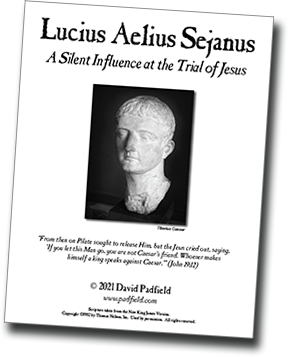Lucius Aelius Sejanus

The stories of the Bible all have a historical context—a context that we can overlook if we are not careful.
In AD 14, when Augustus Caesar died, Tiberius, one of Rome's greatest generals, became Emperor at the age of 55. The following year, Lucius Aelius Sejanus (20 BC–AD 31) became the Prefect of the Praetorian Guard and a trusted advisor to Emperor Tiberius. Sejanus despised the Jews and wanted to exterminate their race.
In AD 31, history suggests that Tiberius' sister-in-law sent a letter to Tiberius informing him of an impending coup by Sejanus to make himself emperor. Tiberius lured Sejanus into a trap where he was summarily executed for treason on October 18, AD 31. Tiberius then sent out a proclamation that the threat of any seditious activity in the Empire was to be crushed immediately. Speeches were made in the Senate condemning Sejanus, and it seems like everyone who knew him suspected of treason as well. Even the children of Sejanus were put to death due to the crimes of their father.
After the execution of Sejanus, Tiberius quickly shifted from an anti-Jewish to a pro-Jewish attitude, or at least a principle of toleration, which Philo, the first century Jewish philosopher, records. The treason of Sejanus caused his memory to be condemned. In ancient Rome, the practice of damnatio memoriae ("condemnation of memory") was the condemnation of Roman elites and Emperors after their deaths. If the Senate or Emperor did not like an individual's acts, they could have his property seized, his name erased, and his statues reworked or destroyed. It was an attempt to erase every trace of the person from the life of Rome as if they had never existed. Among those few who suffered damnatio memoriae was Sejanus. His statues were destroyed, and his name obliterated from all public records. The coins that bore his name were defaced to erase his name. The damnatio memoriae took place about eighteen months before the crucifixion of Jesus Christ.
The connection between Sejanus and Pontius Pilate is hard to ignore! Lucius Aelius Sejanus was the protector or patron of Pilate. When Sejanus fell from power in AD 31, it left Pilate in a very weak position. When their attempts to have Jesus condemned were failing, the Jewish leaders played their trump card by saying, "If you let this Man go, you are not Caesar's friend. Whoever makes himself a king speaks against Caesar" (John 19:12). Before the fall of Sejanus, this threat would have been laughed at, but now Pilate could not ignore it!
Lucius Aelius Sejanus was executed for treason on October 18, AD 31, and just a year and a half later, on April 3, AD 33, our Lord stood before Pontius Pilate. Sejanus is not mentioned in any of the four gospels, but his shadow is seen in Pilate's judgment hall.
This is a free sermon outline book by David Padfield that you can download and print out (12 pages; PDF file size: 811k).
All of the books on this website may be reprinted by individuals, churches, schools, and seminaries for their teaching program. However, these class books may not be altered in any way, and they must be given away at no charge.
